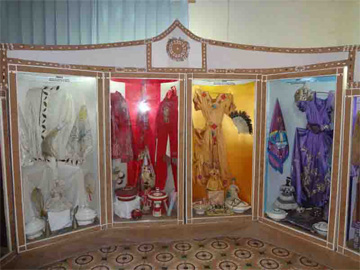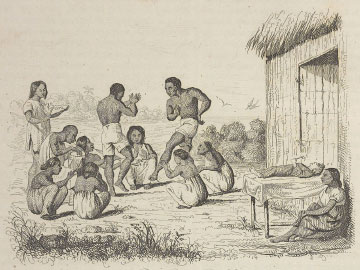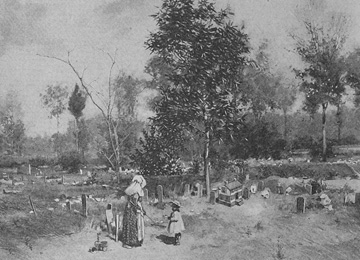Religion and Slavery



Though Africans landed with few possessions, they carried their cultures, skills, and spiritual worldviews into the Americas. Wherever African religions took root in the New World, Africans and their descendants changed and adapted their belief systems to local circumstances and influences. Individual circumstances created variations in the way people practiced their faiths, what they believed, and what significance it held for their lives.
Throughout the Americas, religious beliefs emerged in distinct local forms: for example, Santería in Cuba, obeah and myalism in Jamaica, and voodoo in Saint-Domingue (Haiti). All—and there were many others—allowed Africans and their descendants a social space of their own. The continuation of the slave trade to Cuba and Brazil through the mid-nineteenth century consolidated and strengthened African religions in both countries. The best known perhaps is candomblé in Brazil. In both places, African deities and African religious customs survived in ways they did not elsewhere in the Americas. They also spawned secret societies which were important social institutions among local enslaved people and, again, often fomented unrest among the enslaved.
Though African religions were largely frowned upon by colonial authorities, they nonetheless survived and adapted, enabling enslaved practitioners to enjoy a degree of freedom in the way they conducted their social and private lives. For people whose lives were controlled by intrusive owners, it is hard to overestimate the importance of these religious practices.
Millions of Africans and their New World descendants became Christians, but there were marked differences between slave societies, notably in those dominated by the Catholic and Protestant churches. Catholics tended to welcome Africans, and to convert them simply and with little fuss. Protestant churches tended to insist on instruction and conversion before baptizing Africans into the church. In British colonies, the Anglican church was notoriously hesitant and reluctant to convert enslaved people, largely because of the opposition and hostility of powerful planters in the colonies.
However, the emergence of evangelical dissenting sects in the eighteenth century, especially Moravians, Baptists, and Methodists, saw a major transformation, notably in the English-speaking Americas. Throughout the Caribbean and in North America, slaves were drawn in ever greater numbers to dissenting churches and chapels, converted by evangelical, peripatetic preachers, sometimes by their own masters. Among these expanding armies of Christian slaves, the Bible, but especially the message, imagery, and the stories of the Old Testament, spoke to their enslaved condition, and nurtured their growing demands for freedom and equality.
By the early nineteenth century, increasing numbers of slaves demanded their freedom as Christians. This black Christian voice was heeded and supported by fellow Christian sympathizers in the U.S. North and in the centers of political power in Europe. Christianity was, eventually, to prove one of the major challenges to slavery itself.
Outsiders—Europeans and slave owners across the Americas—tended to dismiss African faiths and practices as mere superstitions. They overwhelmingly viewed African beliefs as idolatry and heathen that lacked the essential customary religions, including religious text. The exception was Islam. It was no accident that those Africans who tended to be spotted as exceptional came from the ranks of African laborers who were practicing Muslims: those who could read and/or write, and those with regular habits of worship, which Christians recognized as paralleling their own religious routines. The rest—many millions—arrived as they left Africa, mere heathens in the eyes of the people who bought and sold them. Indeed, Europeans used the concept of "paganism" to justify their enslavement of people in the first place. In European minds, New World slavery brought the Africans within reach of Christian conversion.
Muslim Africans were scattered through the slave colonies, though they arrived in especially large numbers in northeast Brazil in the early nineteenth century after being captured as victims of Africans wars and enduring the Middle Passage. These individuals were to prove to be a source of great discontent—and trouble—to their owners.
History & Memory
Related Pages:
-
 Municipalities of Regla-Guanabacoa
Municipalities of Regla-Guanabacoa
-
 Mahommah Gardo Baquaqua
Mahommah Gardo Baquaqua
-
 Salvador da Bahia, Brazil
Salvador da Bahia, Brazil
-
 Gowan Pamphlet
Gowan Pamphlet
-
 Municipal Museum of Guanabacoa
Municipal Museum of Guanabacoa

